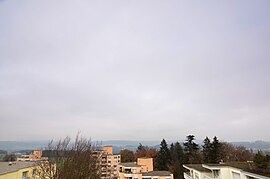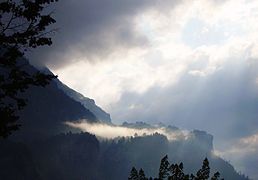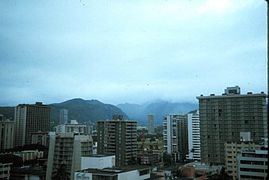stratus
Stratus ( lat. Stratus , second participle of the verb sternere “to expand, spread, cover with a layer”; abbreviation : St ; plural : strati ) is a lower layer cloud , also known as high fog or high fog ( not ground fog ), which when appropriate Weather conditions can reach almost to the surface of the earth.
description
The stratus is completely structureless and consists of fine water droplets. From it often falls precipitation in the form of mist ( "drizzle"), fine ice prisms or snow grains but no heavy rainfall (sleet). These layer clouds usually indicate a rather calm weather situation. At very low temperatures, halos can sometimes even appear around the sun and moon. The stratus has a clearer, but less contoured underside than the nimbostratus and occurs in light winds. Special types of Stratus are nebulosus and fractus , as well as the subspecies opacus , praecipitatio , translucidus and undulatus . For special forms, accompanying and mother clouds, see the article cloud .
Emergence
Stratus clouds arise when the lower layers of the atmosphere are damp and cold, for example due to cooling at night , by supplying moist air or by evaporation after heavy rain. Stratus can also arise from fog when the ground warms up after sunrise. Thin high fog often dissolves at dawn or during the day, but in high pressure weather and inversion weather conditions in winter it can persist for several days.


